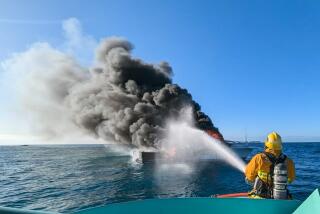L.A. Redux / The City Then and Now
- Share via
There was no baseball field on Catalina Island before chewing gum magnate William Wrigley Jr. bought it for $2 million in 1919, the same year he bought the Chicago Cubs.
After the purchase, improvements were made to a three-acre field. A grandstand was built to seat more than 1,000 and 34 bungalows were added to house players and sports writers.
Then in February, 1921, the Cubs began holding spring training on the island. That year, the “Catalina Cubs,” a hometown team that had formed in Avalon, played the big-league Cubs, only to get trounced, 8 to 1.
Today, you’ll find tennis courts in what was once the outfield, along with a few parked cars and trucks and pieces of scattered litter.
Wrigley was once quoted as saying, “Baseball is the common people’s grand opera.” The Cubs opera played on Catalina for 30 years. In 1952, the team moved its spring training to Mesa, Ariz., where it continues to train. But the memories remain on Catalina.
Kids who lived on the island were let out of school to watch the Cubs’ boat dock in Avalon Harbor each year. The town always celebrated the players’ arrival, sometimes with a parade of elephants, clowns and a marching band.
Former President Ronald Reagan, once a sports announcer, has told the story many times about working for the Des Moines radio station and getting an assignment in California to cover spring training for the Cubs in the early 30s, never to return to Iowa.
Many baseball greats played on Catalina, including catcher Gabby Hartnett and Phil Cavarretta, who had a career batting average of .293. Hartnett once said of the Catalina diamond, “I hope they’ve got those runs banked in the National League infields, because one of my legs is shorter than the other from trying to navigate those damned hills.”
William Wrigley Jr. was one of the 10 wealthiest Americans of his day when he purchased the Cubs and, soon afterward, a controlling interest in the Santa Catalina Island Co. He had never seen the island when he put down his money.
The chewing gum king, a grammar school dropout, died at his winter home in Phoenix in 1932 at age 70. He was buried on his beloved Catalina, near Mt. Ada, named for his wife, who died in 1958.
Today, the 7.3-acre Wrigley field site on Catalina has the original 34 cottages and swimming pool. The area, known as Las Casitas, is being considered as the site for a new civic center, affordable housing, a fire station and a community center.
More to Read
Go beyond the scoreboard
Get the latest on L.A.'s teams in the daily Sports Report newsletter.
You may occasionally receive promotional content from the Los Angeles Times.










